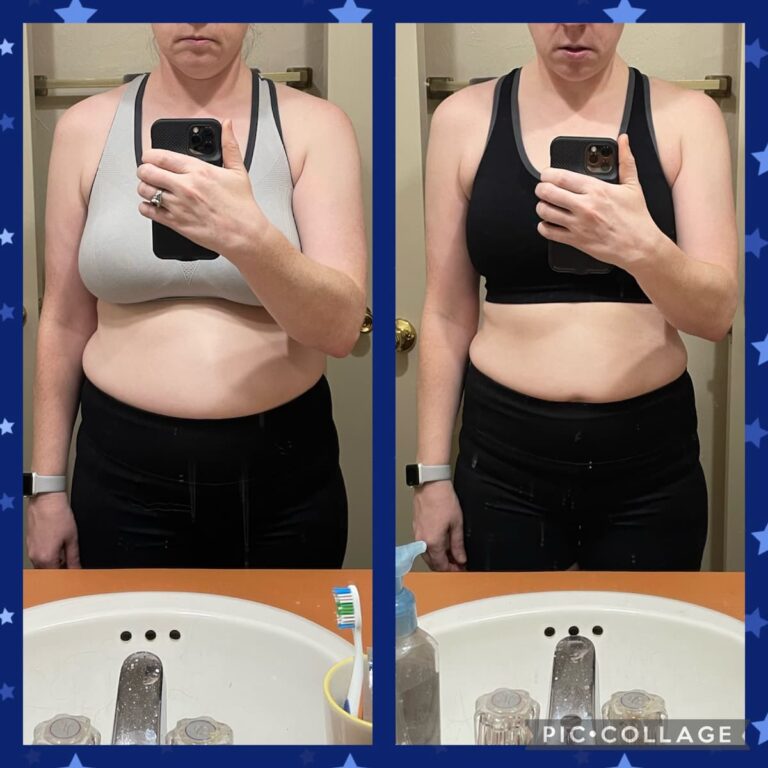These are the easiest tips to burn fat and keep muscle while losing weight. Here’s what you need to know right now.
Whenever looking to achieve a weight loss goal, the actual goal should be to burn fat.
Weight loss can come from a variety of different areas: fat, muscle, water and bone.
If we lose weight from anywhere other than fat, it could have disastrous impacts on our ability to maintain those weight loss results and our long term health.
For example, when we lose weight in the form of muscle it causes the metabolism to slow down. This can result in weight loss plateaus, increased carb sensitivity and needing to eat even less to continue seeing “progress”.
Or when we lose bone (which is also common in standard weight loss), it can decrease our bone density and eventually lead to a health issue known as osteoporosis.
The tricky part is that not all weight loss tools will help you to primarily lose body fat. You need to strategically use tools that help your body hone in on fat loss while minimizing any muscle, bone or water loss.
Today, I’m sharing 5 simple tips to help you burn primarily fat and not muscle.
Let’s dive into it.

1. Eat 30+ grams of protein at every meal
Protein is required to help the body hold onto muscle while burning fat.
Protein is also useful at reducing hunger and preventing cravings by increasing our satiety hormone peptide YY.
But it’s crucial to be eating enough and enough of the right type of protein to see the benefits. Most people are under-eating high quality protein.
The amount each person needs will vary, but a good rule of thumb to aim for when first starting your journey is to get a minimum of 30 grams of complete protein per meal, assuming you’re eating three meals per day.
30 grams of protein would look like:
- 4 1/2 ounces cooked fish
- 4 ounces cooked ground beef
- 3 1/2 ounces cooked chicken
- 4 1/2 ounces cooked shrimp
- 1 1/2 cups greek yogurt
- 1 1/4 cup cottage cheese
- 3 scoops zero sugar whey protein powder
- 5-6 eggs
- 5 1/2 ounces tempeh
You can checkout my 6 Week Body Recomposition Meal Plan with over 50 recipes focused on high quality sources of protein. Each meal has a minimum of 30 grams of complete protein and tastes amazing. French Toast, Cauliflower Nachos, simple lunches and MORE.
Find the program HERE.

50+ NEW RECIPES!
The Body Recomposition
Meal Plan
The 6 Week Summer Meal Plan is focused on the science-backed tips, tools and recipes to help achieve a body recomposition goal.
2. Eat only low glycemic load carbohydrates
Glycemic load is the measurement of how greatly a carbohydrate containing food will raise blood sugar levels.
Low glycemic load carbs are those that don’t have a huge impact on blood sugar levels. Because of this, these carbs help to keep you feeling fuller longer.
Examples of low glycemic load carbs include leafy greens, most fruits, chickpeas, broccoli, squash, mushrooms and pumpkin.
High glycemic load carbs have a big impact on blood sugar levels and can result in a sudden blood sugar crash. This crash can cause severe hunger and cravings for sugary, starchy foods.
Examples of high glycemic load carbs are pasta, white rice, bread and baked potatoes.
There’s a time and a place for higher glycemic load carbs. But when your main goal is fat loss, low glycemic load carbs are ideal.
Related Reading: Complete Glycemic Load Food List
3. Get 8 hours of sleep
Poor sleep raises the hunger hormone ghrelin and the stress hormone cortisol. This combo has been found to increase cravings for sugary starchy foods.
Bad sleep can also reduce the body’s ability to recover from exercise, which can result in decreased muscle mass.(1)
But quality sleep matters just as much as quantity. You can improve your deep, restorative sleep by taking a magnesium supplement, shutting off all technology (phone, tv, laptops, kindles) one hour before bed, and going for a 5-10 minute after-dinner walk.
4. Simplify your drinks
To maximize for fat loss, it’s best to stick to water, sparkling water, unsweetened coffee or tea and zero sugar electrolyte drinks.
These are zero sugar, low glycemic load drinks that help to keep blood sugar levels stable.
Sweetened drinks like soda, energy drinks and sugary lattes greatly spike blood sugar levels and can promote an addictive-like spiral.
Some nutritive “drinks” can also be used while supporting a weight loss goal when done properly.
For example, unsweetened whole milk kefir can be added to a protein, fat and fiber filled smoothie.
Related: High Protein Golden Milk Smoothie Recipe
5. Do 2-3 days per week of total body strength training
The combination of strength training and eating higher protein helps to hold onto muscle while the body burns fat.
But more isn’t always better.
You can see amazing body recomposition results with just 2-3 days per week of total body strength training when done properly. In fact, having 1-2 days of active rest between exercises helps the muscles recover and repair more effectively and therefore reap even more benefits than if you worked out more frequently.
If you are new to strength training, you might want to hire a personal trainer to guide you through the basic movements and create a program suited to your goals and fitness level. However, you can also find free resources on youtube or paid programs through trusted resources.
Kickstart Your Journey
Shop Autumn’s Whey Protein Powder
Our delish bestselling zero added sugar, gluten & heavy metal tested whey protein powder!

















